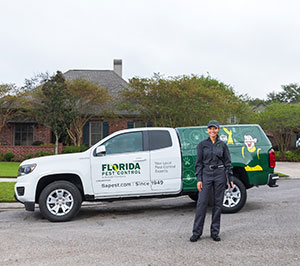High Quality A1 Pest Control Services Charlotte - Secure Your Home
High Quality A1 Pest Control Services Charlotte - Secure Your Home
Blog Article
Bed Insect Treatment Failure: Comparing Chemical Vs. Non-Chemical Solutions
In the world of insect control, especially when dealing with the relentless problem of bed insects, the selection in between chemical and non-chemical treatment services can be a critical one. Both techniques use distinctive benefits and drawbacks, influencing variables such as effectiveness, safety and security factors to consider, and total expense. By examining the nuanced details of each method, a more clear understanding of which course to go after in attending to a bed insect invasion can be attained.
Performance of Chemical Treatments
Chemical treatments for bed pest infestations have actually been commonly acknowledged for their rapid and potent effectiveness in getting rid of these pests. When thinking about the performance of chemical therapies, it is important to recognize that they can supply a fast and detailed option to a bed insect issue.
In addition, chemical treatments have the advantage of using recurring effects, meaning that they can proceed to remove bed pests even after the preliminary application. This residual action is particularly helpful in combating any kind of potential re-infestations. Furthermore, the fast action of chemical therapies can bring alleviation to people facing serious bed pest problems, allowing them to restore control of their home quickly.
Safety And Security Worry About Chemical Solutions
When using chemical options for bed insect therapy is ensuring the security of owners and the setting,One vital facet that calls for careful factor to consider. While chemical treatments can be efficient in removing bed bugs, they may posture threats if not taken care of effectively. One of the main safety interest in chemical remedies is the potential injury they can cause to human health and wellness. Exposure to particular chemicals utilized in bed bug therapies can bring about respiratory problems, skin inflammation, or other negative reactions, specifically in people with pre-existing conditions or level of sensitivities. Additionally, incorrect application or dosage of chemical pesticides can lead to harmful deposits lingering in the cured area, posturing lasting health and wellness dangers to owners.
Additionally, the environmental influence of chemical solutions is one more significant factor to consider. Some pesticides utilized in bed insect therapies may be damaging to helpful pests, wild animals, and ecosystems if they seep right into the soil or water systems. It is necessary to use chemical therapies judiciously, following security standards, and taking into consideration less hazardous alternatives to mitigate these dangers and make certain the efficient and safe administration of bed pest invasions.
Benefits of Non-Chemical Techniques
Thinking about the possible security concerns and environmental influence connected with chemical remedies for bed bug treatment, exploring non-chemical strategies presents an appealing choice with a number of distinct benefits. Non-chemical therapies are environmentally pleasant, as they do not contribute to air or water contamination, making them a sustainable choice for bug control.
In addition, non-chemical services can be reliable in targeting bed bugs, including hard-to-reach locations where chemical therapies might not pass through. Techniques such as warm treatment, vacuuming, heavy steam cleansing, and cushion coverings supply comprehensive elimination without the usage of unsafe chemicals. In addition, non-chemical methods can be less disruptive, calling for marginal prep work and enabling quicker reentry into dealt with areas. Overall, opting for non-chemical bed pest therapy methods not only prioritizes security and ecological protection but also ensures detailed and efficient pest control.
Limitations of Non-Chemical Treatments

In addition, non-chemical treatments often require multiple applications to achieve successful elimination. This can be lengthy and might not always assure complete elimination of all bed pests and their eggs, specifically in surprise or hard-to-reach places.
Furthermore, the success of non-chemical therapies heavily depends on appropriate implementation and thoroughness, which can be challenging for people without expert expertise. Inadequate application of non-chemical techniques might result in incomplete removal, resulting in persistent invasions and the requirement for extra treatments.
As a result, while non-chemical therapies have their advantages, it is crucial to acknowledge these constraints and consider them when determining the most effective approach for handling bed bug problems.
Price Contrast: Chemical Vs. Non-Chemical Options
Given the constraints connected with non-chemical treatments, a vital facet to review in the context of bed bug management is the cost contrast in between chemical and non-chemical alternatives. In contrast, non-chemical treatments like warmth treatment or vapor can be extra costly, with costs ranging from $1,000 to $6,000 for a whole home. While the preliminary expense of chemical therapies may appear lower, multiple therapies might be needed to fully eliminate the invasion, potentially enhancing the overall price.
Final Thought

Thinking about the potential security problems and environmental influence connected with chemical services for bed pest therapy, discovering non-chemical techniques presents an encouraging option with numerous unique benefits.Provided the limitations linked with non-chemical treatments, a crucial facet to review in the context of bed pest monitoring is the expense contrast between chemical and non-chemical options. In comparison, non-chemical therapies like warm treatment or steam can be a lot more expensive, with expenses varying from $1,000 to $6,000 for a whole home. While the initial expense A1 exterminators charlotte nc of chemical therapies might appear lower, multiple treatments may be required to totally eradicate the infestation, possibly increasing the overall cost.In final thought, when comparing chemical and non-chemical bed bug treatment options, it is crucial to consider performance, safety, advantages, constraints, and expense.
Report this page